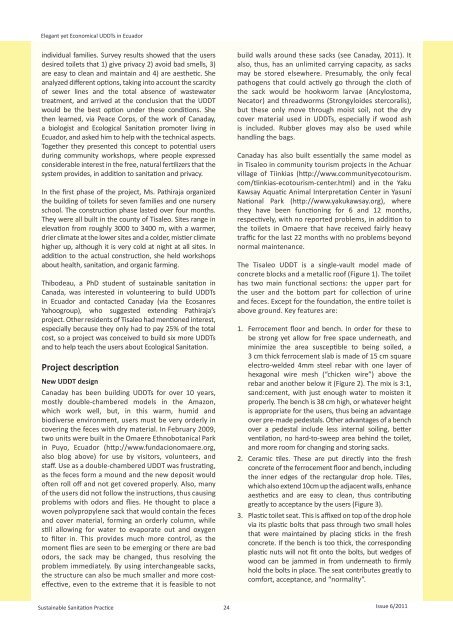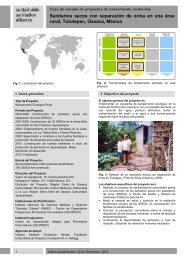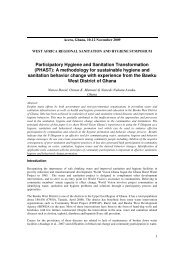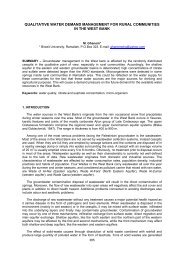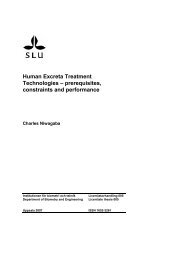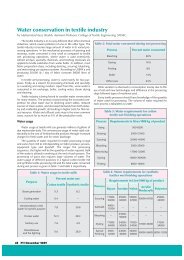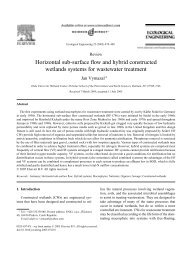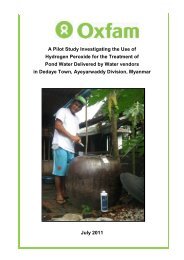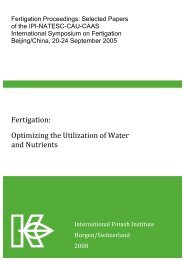Experiences with urine diverting dry toilets - EcoSan Club
Experiences with urine diverting dry toilets - EcoSan Club
Experiences with urine diverting dry toilets - EcoSan Club
Create successful ePaper yourself
Turn your PDF publications into a flip-book with our unique Google optimized e-Paper software.
Elegant yet Economical UDDTs in Ecuador<br />
individual families. Survey results showed that the users<br />
desired <strong>toilets</strong> that 1) give privacy 2) avoid bad smells, 3)<br />
are easy to clean and maintain and 4) are aesthetic. She<br />
analyzed different options, taking into account the scarcity<br />
of sewer lines and the total absence of wastewater<br />
treatment, and arrived at the conclusion that the UDDT<br />
would be the best option under these conditions. She<br />
then learned, via Peace Corps, of the work of Canaday,<br />
a biologist and Ecological Sanitation promoter living in<br />
Ecuador, and asked him to help <strong>with</strong> the technical aspects.<br />
Together they presented this concept to potential users<br />
during community workshops, where people expressed<br />
considerable interest in the free, natural fertilizers that the<br />
system provides, in addition to sanitation and privacy.<br />
In the first phase of the project, Ms. Pathiraja organized<br />
the building of <strong>toilets</strong> for seven families and one nursery<br />
school. The construction phase lasted over four months.<br />
They were all built in the county of Tisaleo. Sites range in<br />
elevation from roughly 3000 to 3400 m, <strong>with</strong> a warmer,<br />
drier climate at the lower sites and a colder, mistier climate<br />
higher up, although it is very cold at night at all sites. In<br />
addition to the actual construction, she held workshops<br />
about health, sanitation, and organic farming.<br />
Thibodeau, a PhD student of sustainable sanitation in<br />
Canada, was interested in volunteering to build UDDTs<br />
in Ecuador and contacted Canaday (via the Ecosanres<br />
Yahoogroup), who suggested extending Pathiraja’s<br />
project. Other residents of Tisaleo had mentioned interest,<br />
especially because they only had to pay 25% of the total<br />
cost, so a project was conceived to build six more UDDTs<br />
and to help teach the users about Ecological Sanitation.<br />
Project description<br />
New UDDT design<br />
Canaday has been building UDDTs for over 10 years,<br />
mostly double-chambered models in the Amazon,<br />
which work well, but, in this warm, humid and<br />
biodiverse environment, users must be very orderly in<br />
covering the feces <strong>with</strong> <strong>dry</strong> material. In February 2009,<br />
two units were built in the Omaere Ethnobotanical Park<br />
in Puyo, Ecuador (http://www.fundacionomaere.org,<br />
also blog above) for use by visitors, volunteers, and<br />
staff. Use as a double-chambered UDDT was frustrating,<br />
as the feces form a mound and the new deposit would<br />
often roll off and not get covered properly. Also, many<br />
of the users did not follow the instructions, thus causing<br />
problems <strong>with</strong> odors and flies. He thought to place a<br />
woven polypropylene sack that would contain the feces<br />
and cover material, forming an orderly column, while<br />
still allowing for water to evaporate out and oxygen<br />
to filter in. This provides much more control, as the<br />
moment flies are seen to be emerging or there are bad<br />
odors, the sack may be changed, thus resolving the<br />
problem immediately. By using interchangeable sacks,<br />
the structure can also be much smaller and more costeffective,<br />
even to the extreme that it is feasible to not<br />
Sustainable Sanitation Practice<br />
24<br />
build walls around these sacks (see Canaday, 2011). It<br />
also, thus, has an unlimited carrying capacity, as sacks<br />
may be stored elsewhere. Presumably, the only fecal<br />
pathogens that could actively go through the cloth of<br />
the sack would be hookworm larvae (Ancylostoma,<br />
Necator) and threadworms (Strongyloides stercoralis),<br />
but these only move through moist soil, not the <strong>dry</strong><br />
cover material used in UDDTs, especially if wood ash<br />
is included. Rubber gloves may also be used while<br />
handling the bags.<br />
Canaday has also built essentially the same model as<br />
in Tisaleo in community tourism projects in the Achuar<br />
village of Tiinkias (http://www.communityecotourism.<br />
com/tiinkias-ecotourism-center.html) and in the Yaku<br />
Kawsay Aquatic Animal Interpretation Center in Yasuní<br />
National Park (http://www.yakukawsay.org), where<br />
they have been functioning for 6 and 12 months,<br />
respectively, <strong>with</strong> no reported problems, in addition to<br />
the <strong>toilets</strong> in Omaere that have received fairly heavy<br />
traffic for the last 22 months <strong>with</strong> no problems beyond<br />
normal maintenance.<br />
The Tisaleo UDDT is a single-vault model made of<br />
concrete blocks and a metallic roof (Figure 1). The toilet<br />
has two main functional sections: the upper part for<br />
the user and the bottom part for collection of <strong>urine</strong><br />
and feces. Except for the foundation, the entire toilet is<br />
above ground. Key features are:<br />
1. Ferrocement floor and bench. In order for these to<br />
be strong yet allow for free space underneath, and<br />
minimize the area susceptible to being soiled, a<br />
3 cm thick ferrocement slab is made of 15 cm square<br />
electro-welded 4mm steel rebar <strong>with</strong> one layer of<br />
hexagonal wire mesh (“chicken wire”) above the<br />
rebar and another below it (Figure 2). The mix is 3:1,<br />
sand:cement, <strong>with</strong> just enough water to moisten it<br />
properly. The bench is 38 cm high, or whatever height<br />
is appropriate for the users, thus being an advantage<br />
over pre-made pedestals. Other advantages of a bench<br />
over a pedestal include less internal soiling, better<br />
ventilation, no hard-to-sweep area behind the toilet,<br />
and more room for changing and storing sacks.<br />
2. Ceramic tiles. These are put directly into the fresh<br />
concrete of the ferrocement floor and bench, including<br />
the inner edges of the rectangular drop hole. Tiles,<br />
which also extend 10cm up the adjacent walls, enhance<br />
aesthetics and are easy to clean, thus contributing<br />
greatly to acceptance by the users (Figure 3).<br />
3. Plastic toilet seat. This is affixed on top of the drop hole<br />
via its plastic bolts that pass through two small holes<br />
that were maintained by placing sticks in the fresh<br />
concrete. If the bench is too thick, the corresponding<br />
plastic nuts will not fit onto the bolts, but wedges of<br />
wood can be jammed in from underneath to firmly<br />
hold the bolts in place. The seat contributes greatly to<br />
comfort, acceptance, and “normality”.<br />
Issue 6/2011


